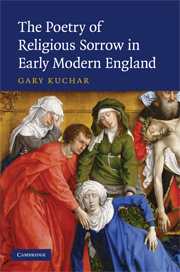Book contents
- Frontmatter
- Contents
- Acknowledgments
- Abbreviations and notes on texts
- Introduction: Of Sighs and Tears
- Chapter 1 The poetry of tears and the ghost of Robert Southwell in Shakespeare's Richard II and Milton's Paradise Lost
- Chapter 2 The poetry of tears and the metaphysics of grief: Richard Crashaw's “The Weeper”
- Chapter 3 The poetry of tears and the metaphysics of grief: Andrew Marvell's “Eyes and Tears”
- Chapter 4 Sad delight: Theology and Marian iconography in Aemilia Lanyer's Salve Deus Rex Judaeorum
- Chapter 5 Petrarchism and repentance in John Donne's Holy Sonnets
- Chapter 6 John Donne and the poetics of belatedness: Typology, trauma, and testimony in An Anatomy of the World
- Conclusion
- Index
- References
Introduction: Of Sighs and Tears
Published online by Cambridge University Press: 22 September 2009
- Frontmatter
- Contents
- Acknowledgments
- Abbreviations and notes on texts
- Introduction: Of Sighs and Tears
- Chapter 1 The poetry of tears and the ghost of Robert Southwell in Shakespeare's Richard II and Milton's Paradise Lost
- Chapter 2 The poetry of tears and the metaphysics of grief: Richard Crashaw's “The Weeper”
- Chapter 3 The poetry of tears and the metaphysics of grief: Andrew Marvell's “Eyes and Tears”
- Chapter 4 Sad delight: Theology and Marian iconography in Aemilia Lanyer's Salve Deus Rex Judaeorum
- Chapter 5 Petrarchism and repentance in John Donne's Holy Sonnets
- Chapter 6 John Donne and the poetics of belatedness: Typology, trauma, and testimony in An Anatomy of the World
- Conclusion
- Index
- References
Summary
Christianity is nothing if not a vast technology of mourning. From David's psalms, to Jeremiah's lamentations, to Jesus' weeping, to Magdalene's tears, Christian scripture draws much of its power of fascination as a religious and literary document from its representations of grief. The fascination elicited by these and other scriptural depictions of sacred sorrow is testified to by the many devotional and artistic traditions they helped engender. In such traditions, Christians are encouraged to generate, temper, interpret, and signify a bewildering array of different forms of mourning – many of which are thought to constitute the very medium by which God makes himself present to the soul. While traditions of religious sorrow are especially characteristic of the later middle ages, post-Reformation culture did not exorcise itself of the medieval fascination with sacred grief so much as it complicated what was already a complex set of practices. The European Reformations introduced into devotional life a series of competing discourses about how one should make sense of the most intimate aspects of one's religious experience as affective in nature. In early modern England, as in virtually all parts of medieval and Renaissance Europe, religious sorrow remained ubiquitous – be it the godly sorrow that works repentance, the sadness for Christ's agony, called compassio, or the despair of perceived damnation.
- Type
- Chapter
- Information
- Publisher: Cambridge University PressPrint publication year: 2008



